6 Challenges of Adopting Heavy-Duty Electric Vehicles
Public transportation and supply chain fleets are facing one of the most significant decisions in modern history — whether or not to adopt heavy-duty electric vehicles (EVs). Drivers find comfort in diesel, having adapted to its shortcomings over the years. Professionals lack a similar familiarity with electrification, making its challenges and unknown solutions all the more mysterious.
1. High Initial Costs
Heavy-duty EVs are still more expensive than their diesel counterparts. A Class 8 diesel truck could cost a company around $180,000, while an electric version with the same potential could run over $400,000, depending on the brand.
Time will tell if the market will make it competitive with conventional options — though there are signs some are already hitting the market. The solution to this is government-initiated assistance. Grant programs, incentives, rebates, and tax credits are several ideas for diverse and accessible financing options.
It makes commitment easier to justify in budgets if returns hit pockets quickly. Organizations offering assistance must publicize them to relevant stakeholders to make the programs successful. Without knowledge-sharing, the initiatives will fail and dissuade lawmakers from supporting EVs in the future.
2. Charging Infrastructure Gaps
Commuters need help finding stations and have opted to install equipment at home. Commercial drivers have an even more extensive infrastructure gap, primarily because the charger level must be higher to accommodate higher-density batteries and fast charging speeds. If long-haul drivers can’t plan a route with reliable stops, a company will never take the EV plunge.
Other industry experts have created solutions to hold truckers over while the grid upgrades and chargers hit more locations. The U.S. The Department of Energy has a search tool to help with travel routing, and private peer-to-peer charging rentals give income opportunities to charger owners.
3. Range Anxiety
Range anxiety affects long-distance commercial drivers more than commuters. Truckers are more likely to trust a gas gauge than a battery percentage, especially as even some commuter vehicles have made headlines for their unreliable reporting. Fortunately, researchers show that 49% of heavy-duty trucks average short enough distances that current EV models can handle.
This suggests electrification is possible in some capacity, even if companies don’t go the total distance. Commercial driving organizations should support development, as this is the focal point of dealing with range anxiety and adding more chargers. If a battery becomes denser, lightweight, and fast-charging, it will combat most range anxiety pain points.
4. Battery Life Cycles and Recycling
Battery development is in flux, with most EVs opting for lithium-ion. Disruptive options, such as hydrogen fuel cells, metal-air, and solid-state, are in research stages with potential for commercialization. These have longer life expectancies compared to the standard lithium-ion, and many are seeking streamlined recycling practices, too.
Trucking earns the U.S. 6% of its gross domestic product, so companies and their contractors can’t afford to spend excess cash on expensive lithium-ion batteries. Instead, the funds should go to expanding recycling infrastructure to consider all battery types, as the market won’t contain simply one style in the future — especially in commercial spaces.
5. Maintenance and Technical Expertise
Truckers have spent decades with their diesel-powered vehicles, learning all their intricacies to fix them in a pinch. The learning curve for electric cars would be severe, potentially leaving the most tenured professionals feeling uncomfortable in the driver’s seat if disaster strikes. Electric drivetrains are novel to many, even mechanics. If companies don’t have educated staff to deal with these issues, there could be more costs than efficiency improvements.
The solution is preemptive training before transitions. This increases the confidence of technicians and drivers alike. It will allow them to perform rudimentary diagnostics and know who to contact in an emergency.
6. Regulatory Barriers
Heavy-duty fleets will need more than training and money to start driving all-electric. They will need to adhere to regulations, which are still in development. Knowing every update in the sector is challenging, but having delegated compliance experts allows companies to stay informed. For example, air quality standards in California are increasing, meaning governments are nudging public transportation to electrify.
Alternatively, the guidance may be so bare bones that fleets can’t yet transition because it is cost-prohibitive or requires technologies businesses can’t access. Supporting policy changes for increased accessibility will make electrification smoother for everyone.
The Heavy-Duty Challenge
Reluctant sector leaders quickly dismiss the value of electrification because of the effort required to get their feet in the door. However, the future won’t give drivers a choice. Governments will mandate it, and clients will expect it. Therefore, now is the time to start transitioning, as early adopters will remain ahead of the curve for a long time.
